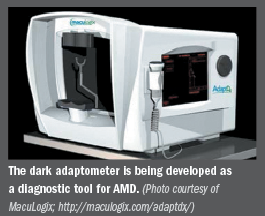Article
New diagnostic technology for AMD
Recently unveiled technology that aims at early detection and tracking of AMD can prevent vision loss and improve quality of life in patients with the disease.
Take Home
Recently unveiled technology that aims at early detection and tracking of AMD can prevent vision loss and improve quality of life in patients with the disease.
By Liz Meszaros
Hummelstown, PA-The AdaptDx from MacuLogix is currently under development as a diagnostic tool for age-related macular degeneration (AMD), and has the potential to be the first practical means for early detection and tracking of this disease, thereby preventing vision loss and improving quality of life in patients with AMD.
“AMD is an interesting disease in that it has a very long incubation,” said John Edwards, chief executive officer of MacuLogix. “Patients can get AMD at the age of 50, for example, and be virtually asymptomatic for 5, even 7 years out. This is while it’s in the dry stage.
“Then there is a precipitous drop-off, within as little as 6 months, where you can go from being 20/20 to substantial vision loss, as the disease transitions from the dry stage to the wet stage. Historically, the problem is that the diagnosis has not come until that transition,” he continued, adding that as many as 40% of patients first diagnosed with AMD are already legally blind in one eye.
The AdaptDx is a functional test that provides an objective measure of dark adaptation-as captured in the rod intercept-or time for recovery of visual sensitivity to a benchmark level. This parameter has been shown, in studies by researchers at the University of Alabama at Birmingham and Penn State College of Medicine, to be a highly accurate and reproducible measure of dark adaptation speed.
“The AdaptDx gives us the opportunity to attack AMD earlier,” Edwards said. “This is a way to start looking at these patients before they’ve had significant vision loss.
“We developed the AdaptDx to try to fill that gap during the largely asymptomatic early phase, to provide an easy way for early discovery of a problem, so that you can start attacking the disease before there is significant vision loss,” he said. “Historically, there hasn’t been a convenient, practical, simple tool that ophthalmology practices can use as a way to detect AMD in its early stages.”

An easy measurement
Dark adaptation impairment can be objectively measured, and occurs earlier in disease progression than visual acuity loss. Based on the patient’s response to a series of stimulus lights, the time constant for how quickly they dark-adapt is measured, providing an early indication of AMD.
“The scientific finding of the correlation between dark adaptation impairment and AMD has been around for at least 25 years, but it is pretty obscure because no one knew what to do with it-until now,” Edwards said.
Traditionally, the way to measure dark adaptation and determine whether it was impaired took up to 90 minutes.
“Our challenge was to take a 90-minute impractical test and take it down to a clinically relevant 5 minutes,” he said. “Now it can be a practical tool, and now, dark adaptation impairment-which has been recognized as a harbinger of AMD-can be made into a practical diagnostic device that can be used in a standard ophthalmology or optometry practice.”
New but familiar
According to Edwards, non-invasive dark adaptation testing is similar to routine perimetry testing for glaucoma, and can be easily done by ophthalmic or optometric techs, taking as little as 5 minutes per eye.
Output is objective and requires no subjective interpretation.
“Visual field analyzers, the Humphrey Perimeter in particular, are the gold standard for how practices diagnose and screen for glaucoma,” he said. “The parallels are tremendous. They are both psychophysical tests and are a very similar experience. The patient experience is the same, the operator experience is the same, the device looks almost the same, and finally, reimbursements are within dollars of each other.
“This is something that will be very familiar to you, because you’ve been doing a very similar thing using a very similar test in glaucoma management for years and years,” Edwards continued. “Here’s an opportunity to do the same thing, in a very familiar fashion, in AMD management. The only difference is that there are three times as many people with AMD as there are with glaucoma.”
Currently, the AdaptDx has 510(K) clearance for sale as a dark adaptometer by the FDA. It is under development as a diagnostic for AMD, but is not cleared for sale as such by the FDA or any other country’s regulatory authority.
Subscribe to Ophthalmology Times to receive the latest clinical news and updates for ophthalmologists.
Newsletter
Don’t miss out—get Ophthalmology Times updates on the latest clinical advancements and expert interviews, straight to your inbox.




